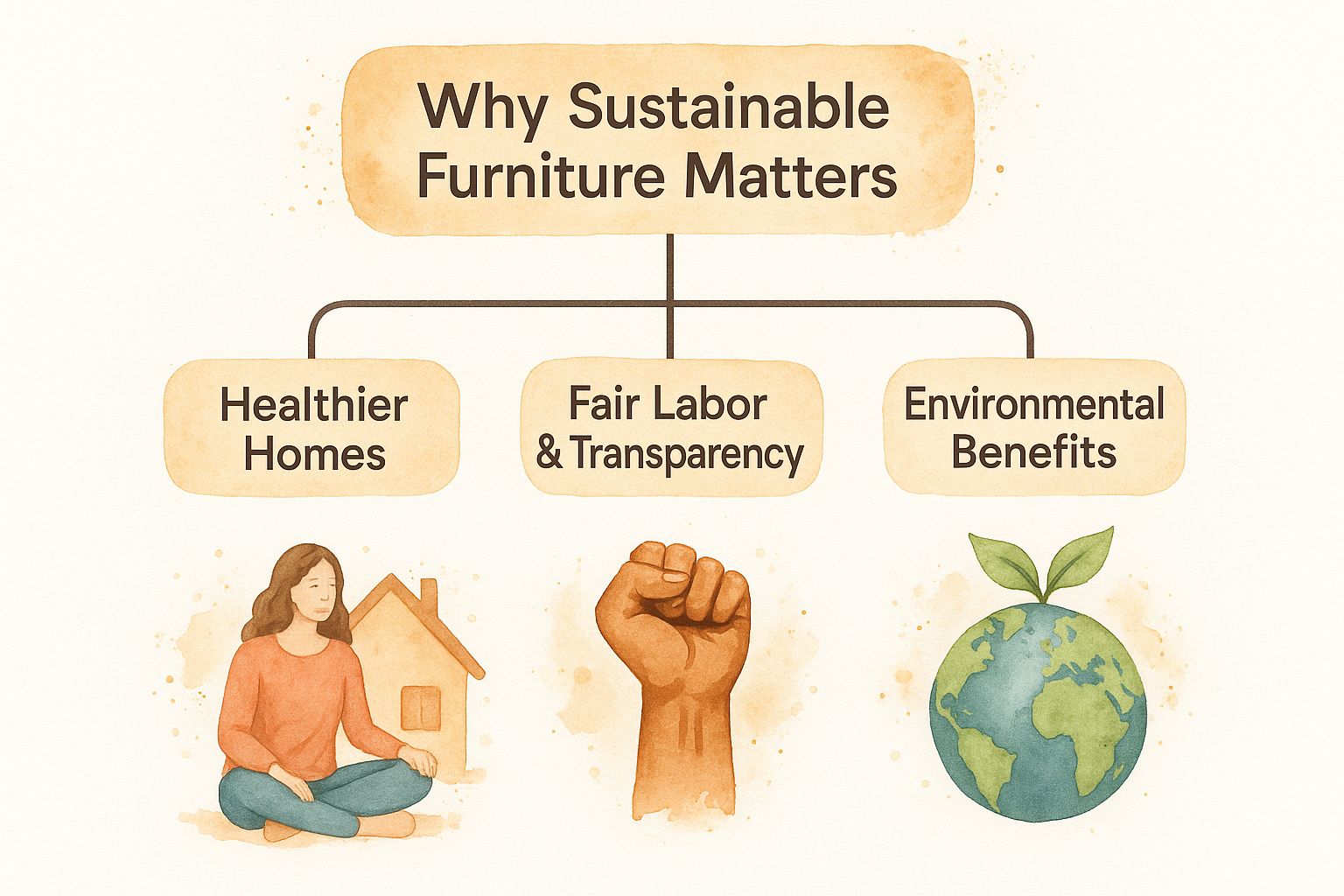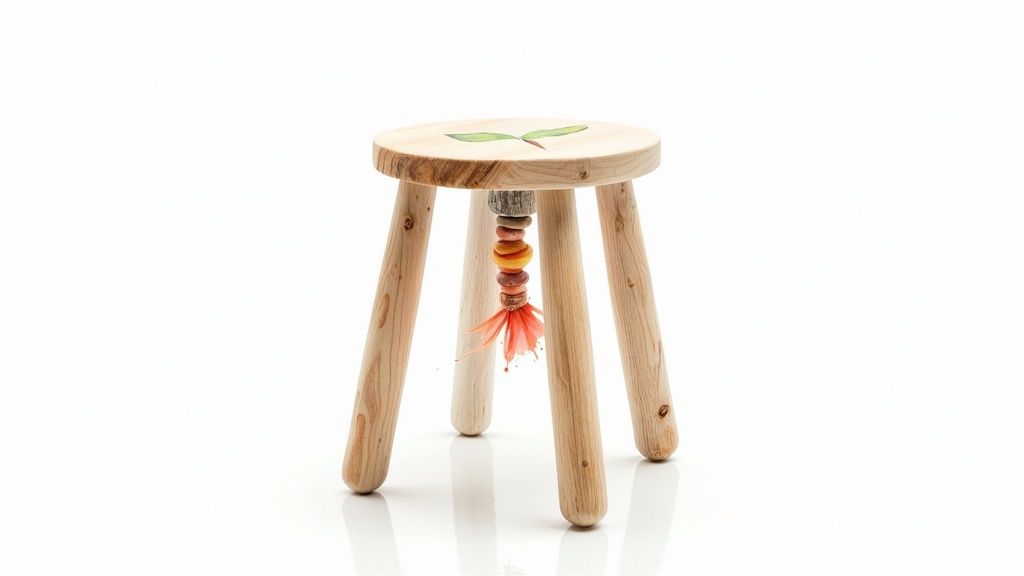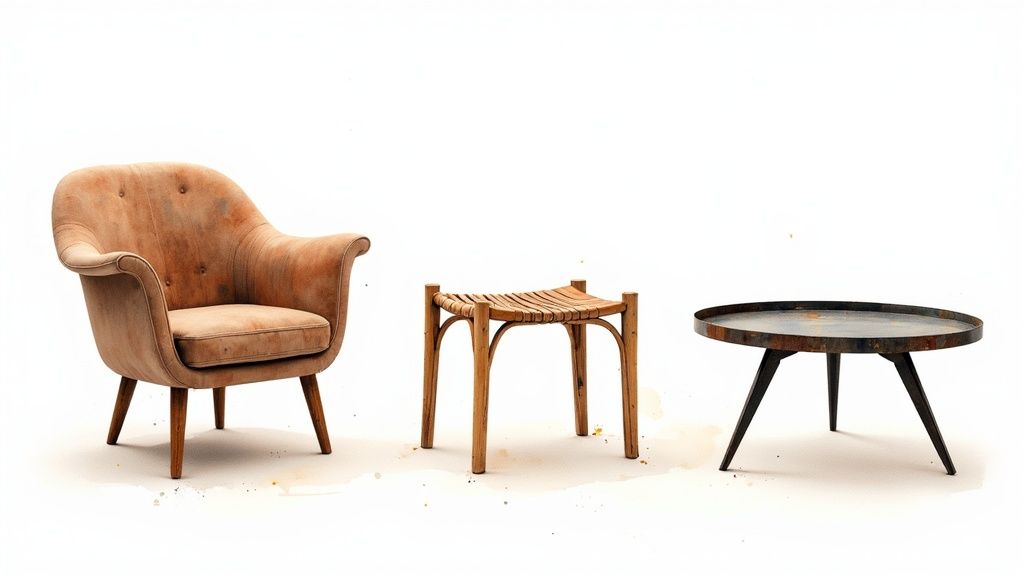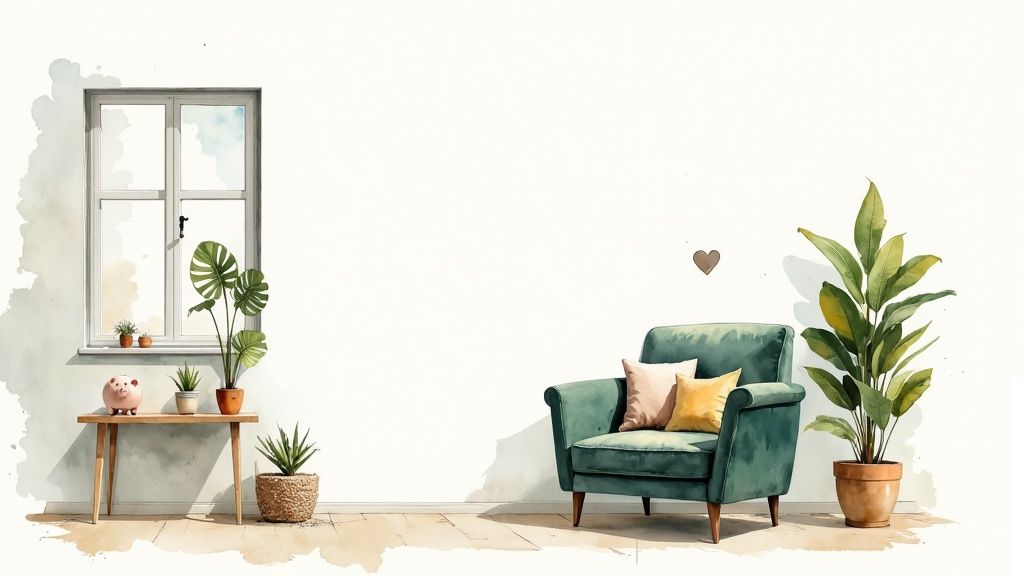
Sustainable Furniture Brands for Your Eco-Friendly Home
Share
Sustainable furniture brands are leading a much-needed rebellion against the world of "fast furniture." Instead of disposable pieces, they're focused on creating furniture from ethically sourced materials, building it to last a lifetime, and ensuring it’s all done under fair labor conditions. It’s less of a trend and more of a total rethink of how we furnish our homes, putting style and substance on equal footing.
Why Sustainable Furniture Is More Than Just a Trend
The draw of sustainable furniture goes way beyond just being green; it’s about crafting living spaces that are healthier and more thoughtful. In the last few years, a lot more of us have started to question the hidden costs of mass-produced goods. We're now seeking out pieces that have a real story and a clear conscience. This isn't just about shopping—it's about a deep-seated desire for quality, longevity, and honesty in the things we choose to live with.
This isn’t a niche market anymore, either. The demand for eco-friendly furniture is actively changing the industry, forcing brands to clean up their act from the moment a tree is felled to the final product on the factory floor.
The numbers don't lie. The eco-friendly furniture market is on track to grow from $43.6 billion to a staggering $100.4 billion by 2034. That kind of growth shows that making sustainable choices is officially mainstream. You can find more details on this market shift over at Market.us.
The Core Drivers of Sustainable Choices
So, what's really fueling this movement? It’s a mix of personal, ethical, and environmental reasons. People want to know what they're bringing into their homes. The infographic below really gets to the heart of why choosing sustainable furniture has become so important.

As you can see, all these benefits are tied together. Choosing sustainable pieces helps create healthier homes, supports ethical work practices, and protects our planet—all at the same time.
This powerful push from shoppers is forcing sustainable furniture brands to be more accountable. In response, they're stepping up their game by:
-
Improving Transparency: They’re opening up their books, so to speak, sharing details about their supply chains from raw materials to the finished product.
-
Prioritizing Durability: The focus is back on high-quality design meant to last for generations, which is the perfect antidote to the wasteful cycle of throwaway furniture.
-
Investing in Certifications: Brands are earning third-party certifications to back up their claims, giving you real confidence in what you're buying.
Choosing sustainable furniture is an investment in your home's well-being and the planet's future. It aligns your personal space with your values, creating a home that feels good in every sense of the word.
What Actually Makes a Furniture Brand Sustainable

The word "sustainable" gets thrown around so often these days that it's easy to dismiss it as just another marketing gimmick. But when we're talking about furniture, true sustainability is much more than a label. It's a whole philosophy built on a careful balance of environmental health, social fairness, and economic viability.
To cut through the noise, I like to think of genuine sustainability as a sturdy, three-legged stool. For the stool to stand firm, all three legs have to be solid and equally strong. If one is short or weak, the whole thing topples over. The same goes for any furniture brand claiming to be sustainable.
Let's break down those three essential "legs" so you know exactly what to look for.
The table below gives a quick overview of what truly defines a sustainable furniture brand, digging into the core criteria you should keep in mind.
The Three Pillars of Sustainable Furniture
Pillar |
What It Really Means |
Examples You Can Look For |
|---|---|---|
Environmental (Planet) |
The brand actively works to minimize its ecological footprint. This covers everything from sourcing materials to manufacturing and shipping. |
FSC-certified wood, use of recycled or reclaimed materials, non-toxic finishes, carbon-neutral shipping options, local sourcing. |
Social (People) |
The company treats everyone in its supply chain—from the foresters to the factory workers—with fairness and respect. |
Fair Trade certification, transparent supply chain, partnerships with artisan communities, safe working conditions, living wages. |
Economic (Longevity) |
The furniture is built to last a lifetime, not just a season. This challenges the "fast furniture" model of disposable goods. |
High-quality craftsmanship, timeless designs, repair programs, use of durable materials like solid wood, lifetime warranties. |
A brand that only focuses on one of these areas isn't telling the whole story. True sustainability happens when all three pillars are working together in harmony.
The First Leg: Responsible Materials
Everything starts with the raw materials. The foundation of any sustainable piece isn't just what it's made of, but where it came from and how it was harvested.
Truly responsible brands are obsessed with their supply chains. They prioritize materials that are either renewable, recycled, or reclaimed, which is a direct effort to fight deforestation and cut down on waste heading to landfills.
Here’s what this looks for in the real world:
-
Certified Wood: Look for the FSC (Forest Stewardship Council) logo. This is your guarantee that the wood was sourced from a forest managed in a way that protects biodiversity and supports the local ecosystem.
-
Reclaimed and Upcycled Materials: This is where things get creative. It's about giving old materials a second act. Think of a stunning dining table crafted from wood salvaged from an old barn or stylish chairs molded from recycled ocean plastics.
-
Rapidly Renewable Resources: Some materials just grow back incredibly fast. Things like bamboo, cork, and certain types of grasses are fantastic, low-impact alternatives to slow-growing hardwoods.
"Yesterday’s waste can be today’s raw material." This simple idea is at the heart of it all. The best brands are finding brilliant ways to turn what was once considered trash into beautiful, functional furniture.
The Second Leg: Ethical Manufacturing
A brand could use the greenest materials on the planet, but if the people making the furniture are working in poor conditions, it completely misses the point. Ethical manufacturing is the second critical leg of our stool, focusing squarely on human dignity and fair labor from start to finish.
This means a commitment to safe working environments, paying wages that people can actually live on, and being open about where and how their products are made. Many of the most trustworthy sustainable furniture brands go the extra mile to get certifications like Fair Trade, which independently verifies their commitment. They often work directly with artisan co-ops, which not only preserves incredible traditional skills but also provides stable, empowering jobs.
The Third Leg: A Long-Lasting Lifecycle
The final leg is perhaps the most powerful counterpunch to our modern "fast furniture" culture: designing pieces that are built to endure. Sustainable furniture is an investment. It's meant to be passed down through generations, not tossed out after a couple of years.
This means you’ll see top-notch construction and timeless designs that won't look dated in a few seasons. A great example is a high-quality, natural solid wood round coffee table—it's built to withstand decades of daily life.
The most forward-thinking brands also have a plan for a product's end-of-life. They might offer repair programs or design their furniture so it can be easily taken apart and recycled, effectively closing the loop and ensuring nothing goes to waste.
How to Read Labels and Certifications Like a Pro
Walking into the world of sustainable furniture can feel a bit like trying to read a foreign language. You're hit with a barrage of logos and labels, each one making a different promise. But learning to decipher these certifications is the single best way to cut through the marketing fluff and make choices you can feel good about.
Think of these labels less as confusing jargon and more as a trusted report card. Each one tells a story. One might be about the health of the forest the wood came from, while another guarantees the person who built the piece earned a living wage. By understanding them, you get to see the whole journey your furniture took to get to you.
It's this knowledge that lets you shop with real confidence, knowing the items you choose for your home genuinely reflect your values.
The Most Common Eco-Friendly Labels
Let’s break down the most important certifications you'll find on products from the best sustainable furniture brands. These are the heavy hitters—the seals of approval that truly mean something.
-
Forest Stewardship Council (FSC): This is the gold standard for anything made of wood. Seeing an FSC logo tells you the timber was harvested from forests managed in a way that protects biodiversity, prevents clear-cutting, and respects the rights of local communities.
-
GREENGUARD Certified: This one is all about the air you breathe at home. A GREENGUARD label means a product has been rigorously tested for low chemical emissions, especially from nasty volatile organic compounds (VOCs). It’s a direct investment in a healthier indoor environment.
-
Fair Trade Certified: This label puts people first. It's your guarantee that the artisans and workers behind a product have safe working conditions and are paid fairly for their craft. You can see this ethical commitment in action with pieces like this carved bone fair trade picture frame.
The rise of materials like certified wood, recycled metals, and non-toxic finishes shows a real shift in the industry. People are paying more attention to the impact of their purchases, a trend driven largely by younger buyers who are happy to invest in certified sustainable goods. If you're curious, you can explore more data on the sustainable furniture market and see just how big this movement has become.
Beyond the Big Three
While FSC, GREENGUARD, and Fair Trade are the main players, a few other certifications can give you an even clearer picture of a brand’s commitment.
A certification is more than just a logo; it's a promise backed by rigorous standards. It's the difference between a brand simply saying they're sustainable and proving it through independent verification.
Keep an eye out for these, too:
-
B Corporation (B Corp): This is a big one. It looks at a company's entire social and environmental impact—from its supply chain and materials to employee benefits and community work. It's a holistic stamp of approval for businesses that are truly a force for good.
-
Climate Neutral Certified: Brands with this label have measured their entire carbon footprint, offset it, and are actively working to reduce it. It’s a direct signal that they’re serious about tackling climate change.
-
OEKO-TEX Certified: You’ll often see this on fabrics used in furniture, like upholstery or cushions. It confirms that every single component, right down to the thread, has been tested for harmful substances and is safe for human health.
Once you get comfortable with these key certifications, you can look at furniture, home decor, and bedding in a whole new way. You're not just picking out a chair, table or bedding; you're consciously curating a space that’s better for you and the planet. The dedication shines through in this Fluent Trends collection.
Top Sustainable Furniture Brands Worth Knowing

It's one thing to talk about the theory of sustainable furniture, but it's another to see it in action. To make it real, let's look at a few incredible sustainable furniture brands that are genuinely leading the way. Each company has carved out its own niche, showing us different—and equally valid—ways to do business responsibly.
These brands are living proof that ethical, eco-friendly design isn't just a trend; it's the future. They've woven transparency, quality, and a profound respect for people and the planet into the very fabric of their businesses. Let's get to know the brands that are setting the new standard.
Avocado: The Leader in Certified Materials
You’ve probably heard of Avocado for their organic mattresses, but their dedication to sustainability shines just as brightly in their heirloom-quality furniture. Everything is handmade in California, where they masterfully use certified, non-toxic, and reclaimed materials. The brand is a true powerhouse of certifications, which takes the guesswork out of trusting their claims.
What really sets Avocado apart is its obsession with verification. So many of their pieces are:
-
GREENGUARD Gold Certified: This means they have low chemical emissions, which translates to healthier air inside your home.
-
FSC-Certified: All their wood comes from forests managed with a conscience, protecting biodiversity and preventing deforestation.
-
Climate Neutral Certified: The company measures its entire carbon footprint and offsets it completely. They're actively in the fight against climate change.
On top of all that, Avocado is a certified B Corporation, a designation reserved for companies meeting the absolute highest standards of social and environmental accountability. From reclaimed wood dressers to solid wood bed frames, every item is built with integrity and designed to last generations.
The Citizenry: The Champion of Ethical Craftsmanship
The Citizenry is built on a simple, beautiful idea: partner directly with artisans from all over the world to create stunning, modern home goods. This brand is a masterclass in the social side of sustainability, guaranteeing that every product is made in a fair and safe environment. Their entire model is a celebration of traditional techniques that supports local economies.
By collaborating with artisan communities from Mexico to Mali, The Citizenry offers handcrafted pieces in small batches. This isn't just about preserving traditional skills; it's about providing artisans with fair wages and stable, empowering work.
The Citizenry proves that beautiful design and ethical production can go hand-in-hand. Each piece tells a story of global partnership and human dignity, directly investing its proceeds back into artisan communities through development grants.
This unwavering commitment to fair trade makes them a go-to for anyone who cares about the human story behind their furniture.
Sabai: The Innovator in Circular Design
Sabai is taking on the "fast furniture" crisis head-on with an impressively innovative and circular approach. Specializing in sofas and seating, Sabai designs every single piece to be repairable, modular, and—when its long life is finally over—recyclable. This makes them a true leader in thinking about a product's entire lifecycle.
Made in North Carolina, Sabai’s furniture is built with things like:
-
FSC-certified wood for a solid, responsibly sourced frame.
-
Upcycled and recycled fabrics, including lush velvets made from recycled water bottles.
-
A modular design that lets you replace just one part—an arm, a cushion, a leg—instead of ditching the whole sofa.
They even have a "Sabai Revive" program where customers can sell their used Sabai pieces, keeping furniture in homes and out of landfills. This relentless focus on repairability and circularity makes Sabai one of the most forward-thinking sustainable furniture brands out there today.
The Real Benefits of Choosing Green Furniture

When you choose sustainable furniture, you’re doing more than just helping the planet. The biggest win is actually for you and your family: creating a genuinely healthier home.
A lot of conventional furniture is built using glues, finishes, and fabrics that quietly release harmful chemicals into the air. These are called volatile organic compounds (VOCs), and they can "off-gas" for years, tanking your indoor air quality.
Believe it or not, the air inside our homes can be two to five times more polluted than the air outside. By picking pieces from sustainable furniture brands, you're bringing home non-toxic, low-VOC materials. It’s a simple switch that makes the air you breathe every day cleaner and safer.
A Smarter Financial Investment
It's true that a well-made, sustainable piece might have a higher upfront cost than something from a big-box store. But think of it as an investment, not an expense. The "fast furniture" industry is built on a cycle of disposability—things are designed to be cheap, break, and get replaced.
Sustainable furniture is the complete opposite. It's built to last. We're talking solid wood, expert craftsmanship, and timeless design that you won't get tired of in a year. These are pieces that can stand up to daily life for decades.
Choosing well-made, sustainable furniture breaks the expensive cycle of disposability. It's an heirloom in the making, not a future landfill item, saving you money over time by eliminating the need for frequent replacements.
This durability means you buy it once and enjoy it for a lifetime, which saves a lot of money (and hassle) in the long run.
Aligning Your Home with Your Values
Beyond the practical stuff, bringing sustainable pieces into your home just feels right. Your home is a reflection of you, and every item in it tells a piece of your story.
When you support brands that are committed to ethical practices—from how they source their wood to how they treat their workers—that story becomes one of integrity. You're casting a vote for a better, more responsible way of doing business.
This choice turns your home into more than just a collection of stuff. It becomes a curated space that feels good on every level—a sanctuary that’s not just beautiful and healthy, but also principled.
Here is the rewritten section:
Your Simple Checklist for Buying Sustainable Furniture
Alright, let's put all this knowledge into action. Think of this as your practical, in-the-moment guide for when you're actually shopping. It’s easy to get overwhelmed, but keeping these few key points in mind will help you confidently choose pieces that are better for you and the planet.
First, Look at the Materials and Labels
The first thing to check is what the furniture is actually made of. You'll want to lean towards natural, recycled, or reclaimed materials. But don't just take a brand's word for it—look for the labels that prove their claims.
-
Wood: Is it solid wood? If so, look for the FSC (Forest Stewardship Council) seal. This is your guarantee that the wood was harvested from a forest managed with the highest environmental and social standards.
-
Finishes: Ask about the paints, stains, and glues. The best options are low-VOC (Volatile Organic Compounds) or non-toxic. A GREENGUARD certification is the gold standard here, meaning the item won't off-gas harmful chemicals into your home.
-
Labor: How were the people who made it treated? The Fair Trade Certified label is a powerful indicator that workers were paid fairly and work in safe conditions.
Then, Dig Into the Brand's Story and Build Quality
A genuinely sustainable brand won't hide its practices. They should be open and proud to tell you where their materials come from and how their furniture is made. If that information is hard to find, it’s often a red flag.
Finally, ask yourself if the piece is built to last. Is the design classic enough to outlive trends? Does the construction feel solid and dependable? Choosing well-crafted furniture is the single most important step in breaking the "fast furniture" cycle of buying and tossing.
Answering Your Questions About Sustainable Furniture
Diving into the world of sustainable furniture can feel a bit new, and it’s natural to have a few questions. Let's tackle some of the most common ones so you can feel confident in your choices.
Is Sustainable Furniture Really More Expensive?
It’s true, you'll often see a higher price tag on sustainable pieces, but it's important to reframe that "cost" as a long-term investment. That price isn't arbitrary; it reflects the true value of better materials, ethical production, and fair pay for the people who made it.
Think of it this way: "fast furniture" is designed to be disposable, needing replacement every few years. In contrast, pieces from sustainable furniture brands are crafted to last for generations. This durability ultimately saves you money by ending that frustrating cycle of buying, breaking, and rebuying.
How Can I Know if a Brand Is Truly Sustainable?
With so much "green" marketing out there, it's smart to be a little skeptical. The key is to look past the buzzwords for real, hard proof.
The best brands don’t just talk the talk; they show you the receipts. They're open about their process and back up their claims with legitimate, third-party certifications.
When you're browsing a brand's website, hunt for official seals of approval. These are the big ones to know:
-
FSC (Forest Stewardship Council): This is your guarantee that the wood comes from a responsibly managed forest.
-
GREENGUARD Gold: This seal means the furniture has low chemical emissions, which contributes to healthier air inside your home.
-
Fair Trade Certified: This tells you that the workers involved in making the product were treated and paid fairly.
If a company makes these certifications easy to find, it’s a great sign they’re genuinely committed to doing things the right way.
What’s the Best Way to Get Rid of My Old Furniture?
Bringing a beautiful new piece into your home is the perfect opportunity to give your old furniture a second life. The goal is to keep it out of the landfill whenever possible.
If your old items are still in good shape, consider donating them to local charities, shelters, or community organizations. You could also sell them or give them away on an online marketplace. For furniture that's truly at the end of its road, check with your local recycling center to see if they have a furniture recycling program.
Ready to find pieces that are as good for the planet as they are for your home? Explore the thoughtfully curated collections at Fluent Trends and discover furniture that’s built to last. https://www.fluenttrends.com
